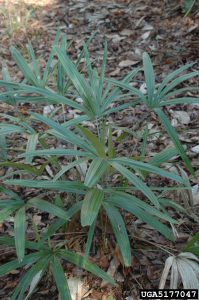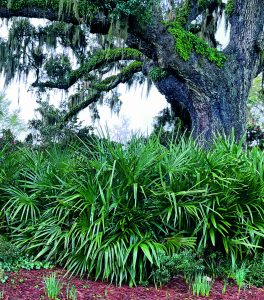Needle Palm, Rhapidophyllum hystrix

Photo by Chris Evans, University of Illinois, Bugwood.org

Photo by Scott Zona
Height: 3-8 feet
Spread: 4-8 feet
LANDSCAPE USE
Useful for accent, as a specimen shrub, in a spaced planting of several individuals, or along the base of elevated decks. Reportedly used with success in parking-lot plantings, but keep it away from walkways as it has very sharp needles. Consider using in a barrier planting to prevent access, as the needles on the trunk will dissuade intruders.
FORM
A mostly single-stemmed, shrublike, evergreen palm with conspicuous, fanlike blades and a short, erect trunk that is covered with numerous sharp-pointed, 8- to 10-inch-long needles.
NATIVE RANGE
Mesic hammocks, ravine bottoms, and edges of floodplain woods. South Carolina, southward to south-central Florida, and west to Mississippi.
CHARACTERISTICS
Flowers: Tiny, inconspicuous, borne among the needles and fibers that encircle the stem. Spring.
Leaves: Fan shaped, 2-3 feet both long and broad, borne on a long stalk.
Fruit: Tiny, reddish brown to purplish brown, borne among the needles and fibers of the stem. Fall.
Bark: The 1-3 foot high stem bears masses of 8- to 10-inch-long, stiff, sharp-pointed needles that are piercing to the touch.
CULTURE
Soil: Rich, moist to very moist, poorly drained soils.
Exposure: Shade to part shade produces best results. Does not like to be in full sun but may tolerate it.
Water: Prefers moist conditions but has been used successfully in parking lots.
Hardiness Zones: 8 to I0.
Life Span: Slow growing and at least moderately long-lived; likely exceeding 50 years.
BEST FEATURES
Evergreen habit, cold hardy and long life span.
COMPANION PLANTS
Yaupon (Ilex vomitoria), Blue-stem Palmetto (Sabal minor), Witch Hazel (Hamamelis virginiana), Devil’s Walking Stick (Aralia spinosa), American Holly (llex opaca), Florida Sugar Maple (Acer saccharum subsp. floridanum), Flowering Dogwood (Cornus florida), American Hophornbeam (Ostrya virginiana), Fringetree (Chionanthus virginicus), Red Buckeye (Aesculus pavia), Blue Beech or American Hornbeam (Carpinus caroliniana).
DISADVANTAGES
The needles that cover the stem are stiff and very sharp.
SIMILAR. AND RELATED SPECIES
Blue-stem Palmetto (Sabal minor) is vegetatively very similar but lacks needles and produces flowers and fruit in long stalks that extend well above the longest leaves. Saw Palmetto (Serenoa repens) has sawlike teeth along the leaf stalk, lacks the needles along the stem, and produces large, conspicuous fruit.